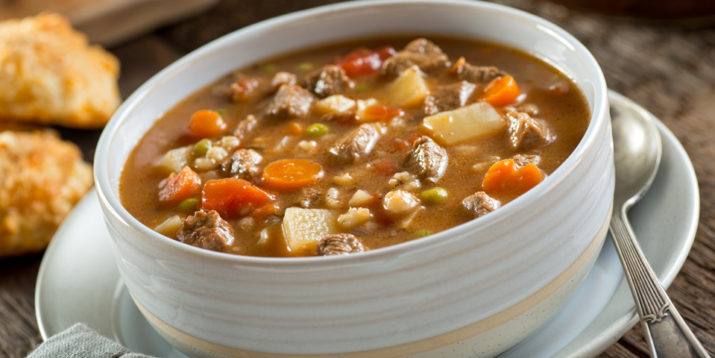How to Make Soup With Leftovers

When I was a kid, I remember reading a story called “Stone Soup.” It was about a traveler who wanders into a small town looking for something to eat but is told that everyone there is starving.
The traveler then produces a stone from his pocket and informs everyone that this is a magic stone, one need only pop it into a pot of boiling water, and presto — instant soup!
The excited townspeople gather up the largest cauldron they can find, fill it with water and light a fire beneath, and while they wait for it to boil the traveler begins to make suggestions.
“I sure wish we had a ham bone, stone soup is extra-delicious with a ham bone,” he says. “I have a leftover ham bone,” one townsman cries, and he runs home to get it.
“I sure wish we had some carrots, stone soup is even better with just a few carrots,” says the traveler. “I have a couple carrots left in the root cellar,” a woman says. “Let me go get them.” And so on and so forth.
I think we all can see where this is headed — the magic isn’t in the stone, it’s in the judicious use of what seemed to be useless kitchen scraps.
The most perfect item to start creating your magic soup stone is a turkey carcass — an enormous pile of flavor-packed, roast bones replete with the juiciest, tenderest bits of close-to-the-bone meat that the carving knife wasn’t nimble enough to discover.
And yet, it’s usually the first thing to go in the trash, followed by that half an onion, two carrots, and three stalks of celery that you had tossed to the back of some refrigerator drawer.
That’s why the morning after any holiday, when I’m making that much-needed pot of coffee, I also fire up a pot of what I’ve come to call my “Holiday Stone Soup.”
Into the largest stockpot I have goes the turkey carcass that I wrapped up and refrigerated from the night before, along with any other leftover bones (perhaps there was a rib roast or a rack of lamb) — all are welcome in stone soup!
I fill the pot almost to the brim with cold water (stocks always begin with cold water to extract all the proteins from the meat), put the pot on the stove, and then I sort my vegetables.
I like to sort my veggies into two categories: those I want in my finished soup, and those I’m using just for flavor.
In the latter category, I usually throw in my alliums (members of the onion family), which would include onion, garlic (cut in half, but no need to peel it), and leeks.
I also throw in any leftover herbs — stems and all — such as sage, parsley, rosemary, and thyme.
Citrus? Why not? A leftover lemon or orange, even a lime is fine, just cut them in half and into the pot.
And don’t forget that knob of ginger. All of these foods are flavor components for the stock and will be strained out of the final soup.
Now bring the whole thing up to a boil, then reduce to the barest simmer. If the stock is boiled too long, it will lose its flavor and turn opaque.
Gently simmered stock, however, will be rich and translucent. Allow it to simmer for at least six hours.
You don’t have much to do during the cooking time other than occasionally checking your water level (if it dips below the surface of the ingredients, top up your pot with more water).
If you want, you can skim any fat and foam from the surface every few hours.
About an hour before dinner, I strain the stock twice. On the first pass, I use a regular colander to catch the big stuff, which I empty into my largest casserole dish and put into the refrigerator to cool.
I strain the stock a second time, but this time through a fine mesh strainer or a colander lined with cheesecloth to catch the smaller bits.
The finished stock goes back on the stove where it’s held at a low simmer.
Now it’s time to prepare that first category of vegetables, the ones we want in our finished soup.
I usually use colorful veggies like carrots, bell peppers, and celery, as well as starchy vegetables like potatoes, sweet potatoes, and turnips. Root vegetables are peeled and everything is cut into roughly equal-sized pieces, the way you want them to look in your hearty bowl of soup.
If you don’t have any starchy vegetables, you can pre-cook some noodles, rice, or quinoa that you can add to your soup at the end.
Twenty minutes before I’m ready to serve dinner, I add all my veggies to the simmering pot and cook them until they are fork-tender.
While they’re cooking, I return to that casserole dish and pick out all the juicy bits of meat that look like something I want to eat, leaving behind the skin, bones, and gristly bits.
Once the veggies are cooked, turn off the heat, add the meat, taste, and season with salt and pepper as needed.
And there you have it — rescued from the trash can, a big ol’ pot of some of the richest, tastiest, most satisfying homemade soup you’ll ever eat.
If there’s more than you can finish (it’s amazing how much food we nearly threw away, right?!) Stone Soup freezes beautifully for up to three months.
